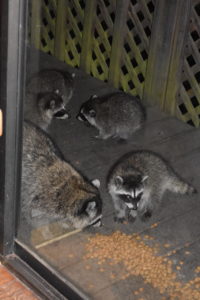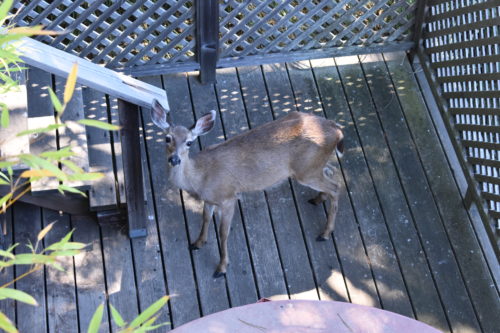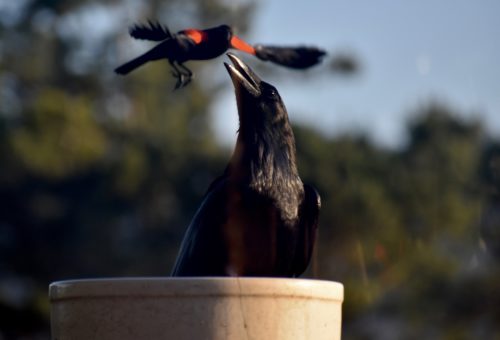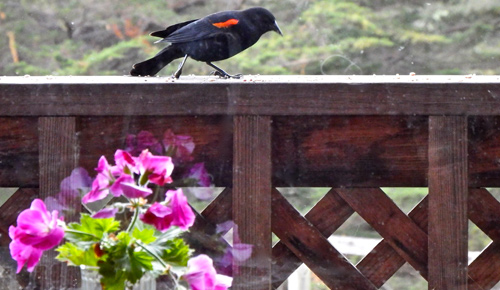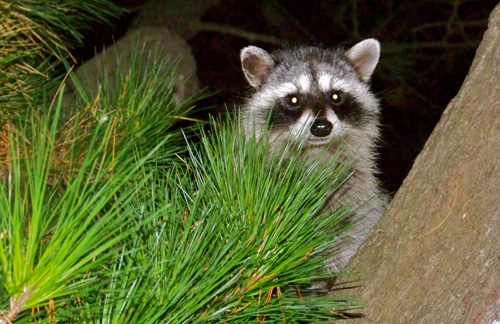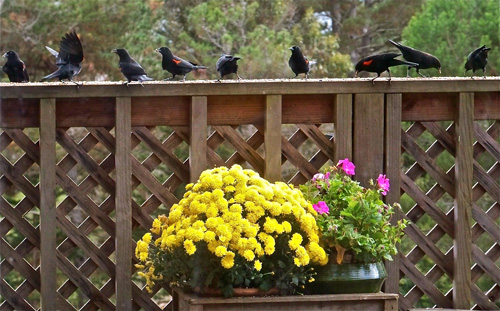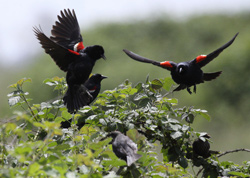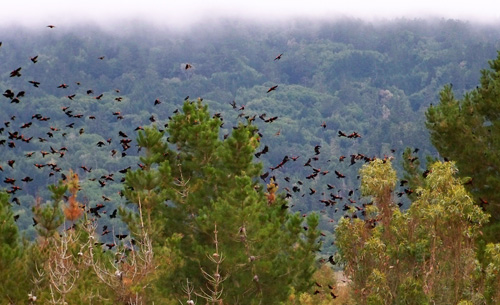Entries tagged with “Red-winged Blackbird”.
Did you find what you wanted?
Fri 29 May 2020
Posted by DavidMitchell under General News, Photography, Point Reyes Station, West Marin nature, Wildlife
Comments Off on Apocalypse later
Caveat lectorem: When readers submit comments, they are asked if they want to receive an email alert with a link to new postings on this blog. A number of people have said they do. Thank you. The link is created the moment a posting goes online. Readers who find their way here through that link can see an updated version by simply clicking on the headline above the posting.
The previously announced closing of the Station House Café this coming Monday has been postponed until after July 4, owner Sheryl Cahill said this week. It could stay open through September if revenue is keeping up with costs. Cahill dismayed West Marin three weeks ago when she said she would close at the end of May because new landlords planned to raise her $100,000 per year rent to $252,000, which she couldn’t afford.
For the next three months, however, her rent is frozen. Once she does close, Cahill hopes to find a new site, and landlord John Hural hopes to find a new restaurateur to rent his building.

This New York Times headline from 10 years ago still amuses me, for it implied that the Palestinian Authority considers indoor plumbing unacceptable in a Muslim country. As it turned out, Hamas was actually upset with women smoking hookahs.

A mother raccoon, who shows up outside our kitchen door every evening begging for kibble, brought four new kits with her the past two nights. They’re very cute and often climb the lattice to the railing but then have trouble climbing back down. They do it headfirst, so it’s a challenge.

Even more of a surprise was this blacktail doe who showed up on our lower deck two mornings ago and then went down some stairs to a still-lower level to inspect our hot tub. My wife Lynn already suspected that a deer had been venturing onto the lower deck at night because some buds in a flowerpot there were getting eaten. I was skeptical, but I guess she’s right.

A male red-winged blackbird repeatedly buzzes a raven drinking from our birdbath and eventually drives him away. Since ravens sometimes eat baby birds, the blackbirds don’t like ’em.
Sun 29 Mar 2015
A guy is driving through Chileno Valley when he sees a sign in front of a ranch house: “Talking Dog For Sale.” He rings the bell. The owner answers and tells him the dog is in the backyard.
The guy goes into the backyard and sees a nice looking Labrador retriever sitting there. “You talk?” he asks. “Yep,” the Lab replies. After the guy recovers from the shock of hearing a dog talk, he says “So, what’s your story?”
The Lab looks up and says, “Well, I discovered that I could talk when I was pretty young. I wanted to help the government, so I told the CIA. In no time at all they had me jetting from country to country. I was able to sit among spies and world leaders because no one figured a dog would be eavesdropping.
“I was one of their most valuable spies for eight years running. But jetting around really tired me out, and I knew I wasn’t getting any younger, so I decided to settle down. I signed up for a job at the airport to do some undercover security, wandering near suspicious characters and listening in. I uncovered some incredible dealings and was awarded a batch of medals.
“I got married, had a mess of puppies, and now I’m just retired.”
The guy is amazed. He goes back in and asks the owner what he wants for the dog. “Ten dollars,” the rancher says. “Ten dollars!” the guy exclaims. “This dog is amazing! Why on earth are you selling him so cheap?”
“Because he’s a liar,” the rancher replies. “He never did any of that crap.”

More canine lore. Even after the brick Grandi Building in Point Reyes Station was reinforced a few decades ago by putting a steel frame inside the building, some concern remained that bricks would pop out of the wall during a major earthquake. That resulted in a warning being painted on the building, but within weeks, pranksters changed “PARKING” to “BARKING.” Nowadays motorists routinely ignore it. This year, the vacant building will turn 100.

Earthquakes are not the only threats to bricks in Point Reyes Station. Here a Western gray squirrel gnaws on a brick outside of Mitchell cabin. Why? “Because they have rootless teeth that keep growing, they must gnaw continuously to wear them down,” explains the Canadian Federation of Humane Societies. “Otherwise they would be unable to close their mouths and their teeth would continue to grow and eventually prevent them from feeding.” Photo by Lynn Axelrod

Lynn and I were enjoying a couple of mocha coffees at Toby’s Coffee Bar Sunday, as we often do, when she noticed this sign on the front of the building. I had no idea what “orse” means, so I looked it up. Turns out its most common meaning in British English is “not comparable.” In short, there’s no stable that can compare with Five Brooks.

Further down the main street I spotted this small sticker on a steel beam that’s part of the Palace Market’s external frame. Chu is a Chinese surname, but that doesn’t explain the sign. I was laughing at it when a woman walked past, read the sign, and with a laugh remarked, “Well, it’s not me.”

A hummingbird flew into Toby’s Feed Barn Sunday and apparently lost its way among the skylights high overhead. There would be no practical way to get to it or catch it, so I’m just hoping it finds its way out soon.

More avian mishaps. Two red-winged blackbirds with injured legs have begun showing up at Mitchell cabin. Neither Lynn nor I could figure out what happened to them, so Lynn asked Dave DeSante, president of the Institute for Bird Populations in Point Reyes Station. His only guess was that they’d gotten their legs tangled in something unknown. So far, at least, they’re surviving. Photo by Lynn Axelrod
A passenger in a taxi leaned over to ask the driver a question and gently tapped him on the shoulder to get his attention. The driver screamed, lost control of the cab, nearly hit a bus, drove up over the curb and stopped just inches from a large, plate-glass window.
For a few moments everything was silent in the cab. Then, the shaking driver asked, “Are you OK? I’m so sorry, but you scared the daylights out of me.” The badly shaken passenger apologized to the driver and said, “I didn’t realize that a mere tap on the shoulder would startle someone so badly.”
The driver replied, “No, no, I’m the one who is sorry. It’s entirely my fault.
Today is my very first day driving a cab. I’ve been driving a hearse for 25 years.”
Mon 29 Sep 2014
Animal populations around here fluctuate noticeably from year to year with weather, disease, and predators all having an impact. This week we’ll discuss two species that have been affected in recent years: common raccoons and Tricolored Blackbirds.

A common raccoon in a pine tree next to Mitchell cabin where there’s no hunting allowed.
During my 39 years in West Marin, I’ve seen the number of raccoons and grey foxes simultaneously soar, plunge, and soar again. It’s happened several tines, and the culprit has usually been distemper, a viral disease that’s spread by inhalation and is fatal about half the time. It attacks the gastrointestinal and respiratory tracts, as well as the spinal cord and brain.
At the moment, the coast’s raccoon population appears to be thriving. In fact, raccoons are doing well nationwide. This wasn’t always the case. In the first three decades of the last century, the popularity of raccoon coats, especially for riding in convertibles, resulted in the animals being so heavily hunted and trapped that the common raccoon became far less common.
When prices for raccoon pelts eventually dropped, the number of raccoons made a comeback. Then it was television that took a toll on their population. For example, only about 388,000 were killed in the 1934-35 hunting season, Virginia C. Holmgren writes in Raccoons: In Folklore, History & Today’s Backyards. But in the 1950s, three TV episodes about Davy Crockett started popularizing coonskin caps to where 5.2 million animals were taken in the 1976-77 hunt. The average pelt sold for about $20.
A drop in pelt prices once again greatly reduced the take in subsequent years. This past February, 490,361 raccoon pelts were sold at the North American Fur Auction in Nevada, but fetched only $14.05 to $21.61 apiece. “Raccoon and bobcat prices [$73.25 to $393.49] didn’t exactly tank, but were lower than previous levels,” the Nevada Trappers Association reported afterward.

Fall colors on the deck.
Around Mitchell cabin, a few of the birds that at first glance appear to be Red-winged blackbirds are actually Tricolored Blackbirds. Just below the red patch on their wings is a small patch of white feathers, which is hard to see except when their wings are outspread. ______________________________________________________________
 When flying, a Tricolored Blackbird’s white feathers are visible below and behind its red feathers. Audubon photo by Linda Pittman
When flying, a Tricolored Blackbird’s white feathers are visible below and behind its red feathers. Audubon photo by Linda Pittman
The color of that patch of feathers is the key to identification. If it’s yellow, you have a Red-winged blackbird. If it’s white, you have a Tricolored.
Tricolored Blackbirds were once one of the most common birds in California and until recent years lived on Point Reyes in great numbers. A few years back, ornithologist Rich Stallcup, who died in 2012, wrote that 30 years of bird surveys had found that “on outermost Point Reyes…. the winter population has ranged from 4,500 to 11,000 individuals…. Perhaps 8 to 10 percent of the world population.”
However, when the Horick Ranch folded in 2000 and the Point Reyes National Seashore took possession of it, the Park Service removed the cows and the dairy shut down, Stallcup noted. “This significant reduction in foraging opportunities may have, and have had, a serious impact on the size of the colony, which has dropped from about 1,500 nests in 2000 to less than 650 in 2003.”
Although Stallcup initially conceded that the dramatic drop in the number of Tricoloreds on Point Reyes could be within the range of normal fluctuation, several months later he sounded an alarm. “For the first time in many years, Tricolored Blackbirds are not now (August 2004) nesting in Point Reyes National Seashore. This condition is probably due to reduced foraging opportunities.”
In other parts of the state, Tricoloreds are also struggling to survive. _________________________________________________________________

A variety of blackbirds show up together at least twice a day to peck birdseed off the railing of the deck. But as seen in this photo from 2013, there were far more of them around here a year ago.
“In the 19th Century, Tricolored Blackbird flocks were described as so numerous ‘as to darken the sky,'” the Audubon website notes. “Over just the last 70 years, the Tricolored Blackbird population has decreased by more than 80 percent.” And the decline is continuing. The number of Tricoloreds in California fell by 44 percent to 145,000 in the past three years alone,” The Los Angeles Times reported on Aug. 5.
“The reasons for this decline are many, but the loss of marsh and nearby foraging habitats along the coast and in the Central Valley is the main issue,” according to Audubon. “In more recent years, the species has become dependent on agricultural lands, with most of the largest colonies nesting in grain fields.
“A real dilemma develops because Tricolored young typically have not yet left the nest before the time farmers harvest their crop, and harvesting destroys Tricolored Blackbird nests and young. In some cases as many as 20,000 nests have been lost in a single field.”
“As part of an effort to save the species, Audubon California and the U.S. Department of Agriculture’s Natural Resources Conservation Service are leading a program that pays dairy farmers to delay harvesting their silage crops through the nesting season,” The Times added.
Here at Mitchell cabin we’re trying to do our part by making sure that hungry blackbirds regardless of age or species can find the birdseed they need to thrive. ________________________________________________________________
News from the great outdoors is often fascinating, of course. Here’s a headline I spotted online last week.

Now let’s get this straight. Who’s ambushing whom? Reuters article as headlined in Google News

